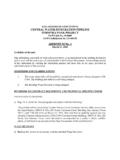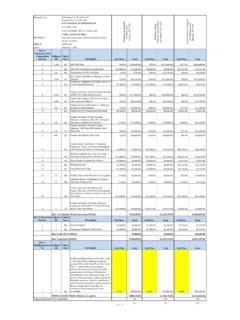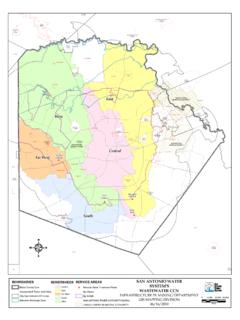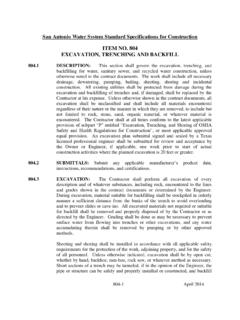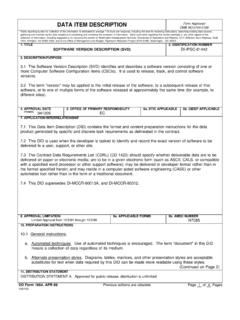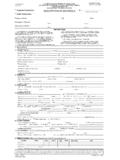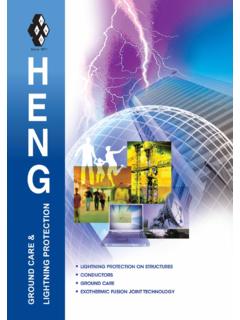Transcription of ITEM NO. 3000 HANDLING ASBESTOS CEMENT PIPE
1 San antonio water system Standard Specifications for Construction 3000 -1 April 2014 item no . 3000 HANDLING ASBESTOS CEMENT pipe INTRODUCTION: This item shall govern the uncovering, dislodging, HANDLING , removing, transporting, and disposing of ASBESTOS CEMENT (AC) pipe and other ASBESTOS containing materials (ACM). AC pipe is also known as transite pipe . AC pipe typically contains from 15% to 20% chrysotile and crocidolite ASBESTOS and is considered to be an ASBESTOS -containing material.
2 The disturbance and/or removal of this material is governed by the National Emissions Standards for Hazardous Air Pollutants (NESHAP) 40 Code of Federal Regulations (CFR) 61; by the Occupational Safety and Health Administration (OSHA) 29 CFR ; the State of Texas Occupation Code, Chapter 1954 and Health and Safety Code Chapters 361 and 363; and the Texas Administrative Code (TAC), 25 TAC Chapter 295 and 30 TAC Chapter and The material is classified by definition under 40 CFR 61, Subpart M, Section as Category II, non-friable ACM, unless, when dry, it can be crumbled, pulverized, or reduced to powder by hand pressure.
3 At that time , it becomes classified as regulated ACM (RACM) and subject to regulation under Subpart M. It is the intent of this specification to define procedures that maintain the AC pipe in an intact state. Contractors shall not use procedures that subject the AC pipe to forces that will crumble, pulverize, or reduce to powder the AC pipe . By using procedures that have a low to no probability of fiber release, the pipe retains its classification as Category II, non-friable ACM.
4 These procedures will protect workers from the health risk associated with airborne ASBESTOS . References to the City of San antonio (COSA) pertain only to those joint bid projects, where joint jurisdiction occurs due to the contract s binding agreement. Definitions used and incorporated as part of this specification are located in Appendix One. Applicable standards and guidelines used and incorporated as part of this specification are located in Appendix Two. GUIDANCE: If the project specifies an ASBESTOS Removal Work Plan (or, ASBESTOS Abatement Plan) be provided and approved as part of the project documents, the following guidelines should be used for the document to be considered acceptable.
5 Refer to Appendix Three of this specification for more specific guidance of addressing an acceptable procedure for HANDLING SAWS AC pipe . Plans submitted with insufficient detail will be returned requesting more information be provided. 1. The governing documents for SAWS ASBESTOS - CEMENT (AC) pipe are as follows: San antonio water system Standard Specifications for Construction 3000 -2 April 2014 a. Environmental Protection Agency (EPA), 40 Code of Federal Regulations (CFR) Part 61, Subpart M National Emission Standards for ASBESTOS ; b.
6 Occupational Safety and Health Administration (OSHA), 29 CFR , ASBESTOS ; c. The State of Texas Statute, Health and Safety Code, Chapter 363; d. Texas Administrative Code (TAC) 30 TAC Chapter 330. 2. OSHA classifies the HANDLING and removal of ASBESTOS containing material (ACM) as Class II ASBESTOS work. As such each contractor shall acknowledge that their program complies with OSHA standard 29 CFR and shall describe how their program complies with that standard.
7 It should be included in the contractor s submission meeting SAWS Spec 902, Safety and Health Program. 3. The San antonio water system AC pipe is considered by the EPA as Category II, non-friable ASBESTOS containing material (ACM). The SAWS wants its pipe to retain that ASBESTOS categorization. To accomplish that goal SAWS requires that no force be applied to the pipe that would cause it to become crumbled, pulverized, or reduced to powder by hand pressure unless wet techniques are used when a force is applied.
8 Once the pipe becomes crumbled, pulverized, or reduced to powder it becomes classified as regulated ACM. (40 CFR ) 4. The plan submitted shall contain the following: a. The scope of work to be accomplished shall be described in detail. Be specific as to the involvement with the existing AC pipe . For example: abandoning/removing X feet of AC pipe ; tying into one or more joint(s)/section(s) of an existing water main and replacing one or more joints/sections (X feet) of pipe to make the connection; removing X feet of buried AC pipe encased in concrete crossing a drainage way not accessible by road; or connecting to an existing joint/section of AC pipe by tapping into the AC pipe .
9 B. Detailed procedures that describe the methods/techniques to be employed to uncover, dislodge, handle, remove, secure, transport, and dispose of the AC pipe and any San antonio water system Standard Specifications for Construction 3000 -3 April 2014 generated ACM waste. For illustrative purposes only the following is an example of the level of detail expected in a plan. The contractor could use them as a basis for preparing their plan. If the contractor employs this example, SAWS requires greater site specific detail in the plan submitted.
10 DESCRIPTION: This item shall consist of the uncovering, dislodging, HANDLING , removing, transporting, and disposing of AC pipe , joints, wrappings and other ACM. To comply with NESHAP and OSHA requirements, this project will require workers trained in using wet technique procedures to dislodge and remove AC pipe , AC pipe joints, valves (any type) containing ACM, and any surrounding soils that may contain ACM. The Contractor shall develop an ASBESTOS Removal Work Plan, herein referred to as the Plan , (see Appendix Three, Example Procedures) that provides specific and detailed procedures they and/or any of their subcontractors will follow to maintain the AC pipe in an intact state.
